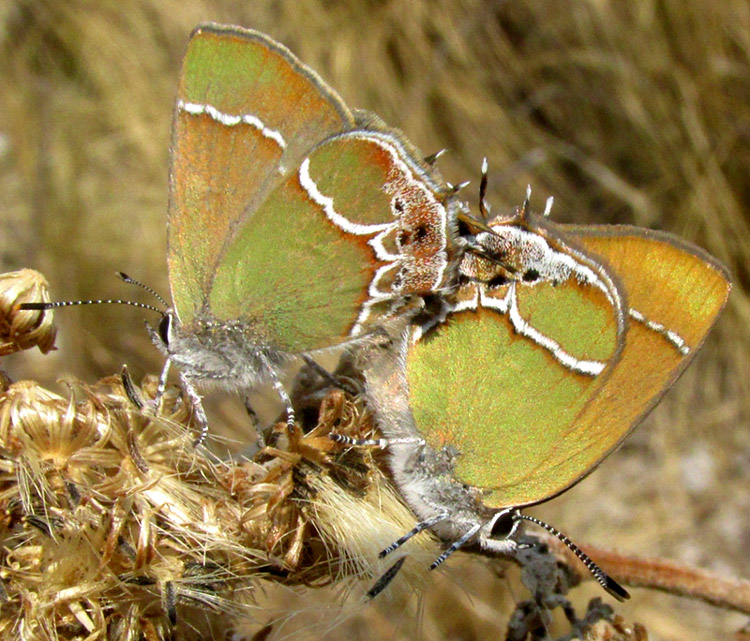Excerpts from Jim Conrad's
Naturalist Newsletter
entry from field notes dated May 4, 2023, taken about 150m uphill on NE-facing slope, above intersection of road from Hwy 120 to San Joaquín, with road to El Doctor; juniper and pine forest on limestone bedrock; elevation ±2425m (7950 ft); Eastern Sierra Madre mountains of east-central Querétaro state, MÉXICO, (N20.88°, W99.62°)
XAMI HAIRSTREAK

Despite their colors camouflaging them amid the drought-parched landscape, the above caught my eye as a kind of disharmonious textural presence: something flat, smooth and bilaterally symmetrical where random crumbly graininess was expected atop a wildflower's disintegrating fruiting head. Finally recognizing two small butterflies mating, I wondered if a predatory bird's mind ever would have seen it. The butterflies remained motionless as the camera neared, except for the antennae of one vibrating nervously, or maybe rapturously.
Their size, color and, especially, the decorations at the end of their hindwings, suggested one of the many hairstreak butterflies, of the Hairstreak Subfamily the Theclinae, of the Gossamer-wing Family, the Lycaenidae.
Many hairstreak species are recognized. The above picture was sent to volunteer butterfly-identifier Bea in Ontario, who quickly determined our find as the Xami Hairstreak, CALLOPHRYS XAMI. I'm not sure how "Xami" is to be pronounced, but with many Mexican names beginning with X, the X is pronounced as if it were "ch" -- CHA-mee. If the X resides inside the name, it varies, "sh" in Tuxtla, "hee" in México.
Xami Hairstreaks occur from Arizona and central Texas south into Guatemala, mainly in upland canyons and mountain slopes with temperate climates, and forested with conifers like our slope's junipers and pines.
A noteworthy feature of the behavior of Callophrys xami is that the males are exceptionally territorial; they aggressively compete for the best location. They need host plants for their larvae to feed on, and for Xami Hairstreaks that's mainly members of the Stonecrop Family, the Crassulaceae. Our picture was taken where large populations of Red Stonecrop were established among outcropping limestone rocks and beneath junipers and pines. Females lay their eggs on the plants, and the resulting larvae feed on them. I read that in this species copulation can last up to two days, so that might explain our butterflies' hesitation to decouple. Much more life cycle information is available on Wikipedia's Callophrys xami page.
In hairstreak species often the slender hairlike appendages at the back part of the hindwings, along with various spots and colored blotches, at a distance might to a predator look like the antennae and eyes of a creature. This may cause a predator to attack the hindwings' designs instead of the head, or maybe even frighten the predator. One of the most striking examples of this strategy was shown by the Zebra-striped Hairstreaks we commonly saw in the Yucatan. To a predator, our coupled pair as a unit possibly look like a Gasteracantha spider, or maybe a tailless whip-scorpion ready to lunge.